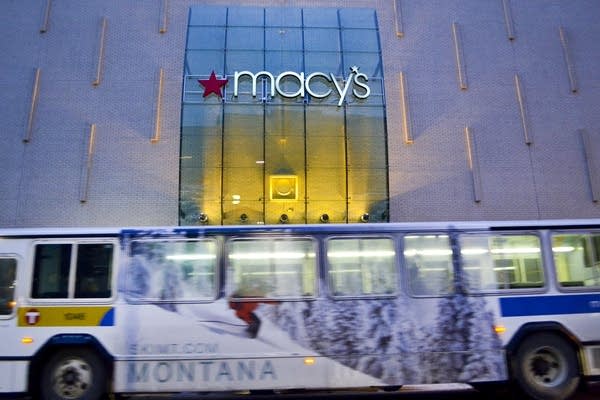What's next for downtown St. Paul?

Business leaders admit that the official news of Macy's closing was like a kick to the gut. They saw it coming, but it still hurt.
Yet Mayor Chris Coleman is quick to put the closure in perspective. For all the fond memories longtime residents have of shopping at downtown department stores, that's not the future, he said.
"Waxing nostalgic of how downtown St. Paul used to be in 1940 is missing the point of what downtown St. Paul is going to look like in 2020," Coleman said.
Coleman said Macy's was no longer a destination that drew people to the area. What does bring people to the city's core, he says, are the places that cannot be found at a suburban shopping mall. Coleman raves about his favorite downtown menswear store, Heimie's Haberdashery, where one can find tailored suits as well as get a clean shave. That's where downtown is heading, he said.
Create a More Connected Minnesota
MPR News is your trusted resource for the news you need. With your support, MPR News brings accessible, courageous journalism and authentic conversation to everyone - free of paywalls and barriers. Your gift makes a difference.
"If you're going to go into a downtown, you want something that's unique. You want something you can't get anywhere else."

Coleman's office has already recruited music venues, bars, and niche shops that are fueling a small revival.
And next year, there is more to come. Light-rail trains on the Green Line will start rolling. Construction of a regional ballpark in Lowertown will be well underway. The site of the old Pedro luggage store could become a new park. A Lunds grocery could open by the end of this year, along with more than 250 apartments on top of it.
Even developers of other housing projects are excited by what a full-service grocery store will mean for the neighborhood.
"A lot of the kids I talk to who live downtown right now, the only reason they even have a car now is to run out to Robert Street to Cub Foods or Rainbow to get groceries," said Clint Blaiser, one of the investors reshaping the vacant Pioneer-Endicott office buildings into high-end apartments. "I think with Lunds coming, I think we'll get more competition in that area, too."
Blaiser said a critical mass of residents, from young professionals to empty nesters, is finally paying dividends for downtown. City planners say about 8,500 people live there, an increase of 28 percent over 12 years. They expect additional growth of 9 percent over the next few years.
DEVELOPING DOWNTOWN VISION

But what is the role of government in developing its vision? The city has raised some eyebrows by taking over the grocery-and-apartments project known as the Penfield. Many say in an ideal world, such developments should be built by the private sector.
Today's economy, however, is far from ideal, said Matt Kramer, president of the St. Paul Area Chamber of Commerce. With some reservations, he applauds the city for jump-starting the project after the housing market collapsed.
"All of us were growing tired of seeing the Penfield sign that said, 'Coming this fall,'" Kramer said. "And you're sitting there mentally counting, 'One, two ... oh yeah, it's been seven years of 'coming this fall.'"
ARE THE HEYDAYS OVER?
Civic boosters say the days of behemoth projects are over. It's been years since St. Paul has built a skyscraper, recruited a professional sports team, or enjoyed a strong nucleus of retail options.

It isn't hard to find long-timers pining for old downtown St. Paul. One doesn't need to look further than the mayor's own family.
Long-time St. Paul resident Nick Coleman is a journalist, former newspaper columnist, and the older brother of Mayor Coleman. He says at the core of downtown is a dead zone where city leaders once promised vibrancy. He's not ashamed to say he misses the downtown department stores.
"I just find there's too much emphasis on cool nightspots, hipsters, and music, and not enough really for the residents, the taxpayers, the long-time suffering citizens of the city. Something seems to be missing," Coleman said. "I'm 62 years old, and I get offended when people act like, 'the St. Paul you remember, that's of the long distant past and it'll never be like the 1930s.' Well, I wasn't here then, either."
Coleman said St. Paul has to be more than a place where hipsters can buy posters or earbuds. He says now that St. Paul has gotten the glitter, it's time to rebuild its core.
City planners say they don't know how long it will take to redevelop the Macy's site. When light-rail trains begin to cruise down Cedar Street next year, they could roll past an exciting new offering — or an empty shell.
— Follow Laura Yuen on Twitter: http://www.twitter.com/laura_yuen


